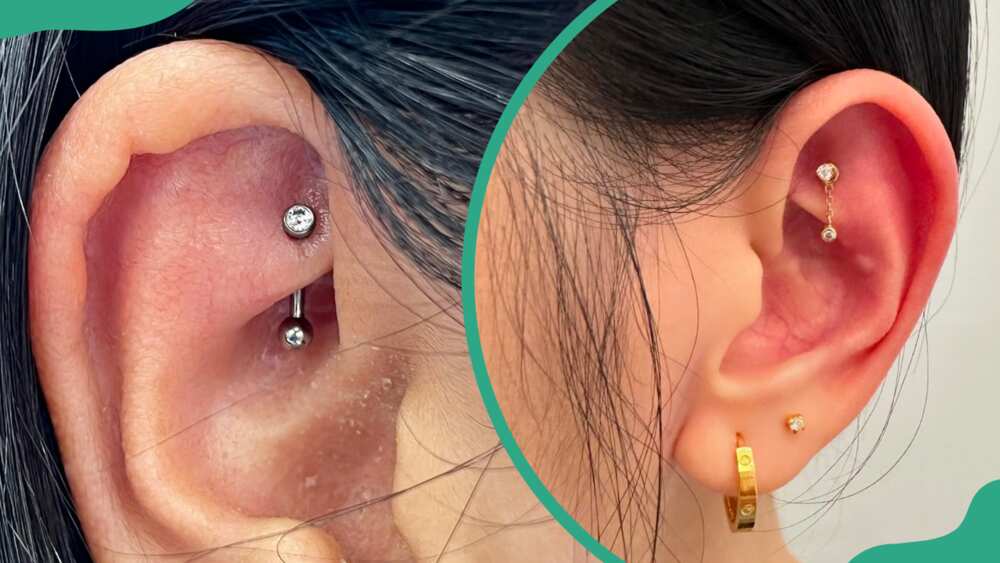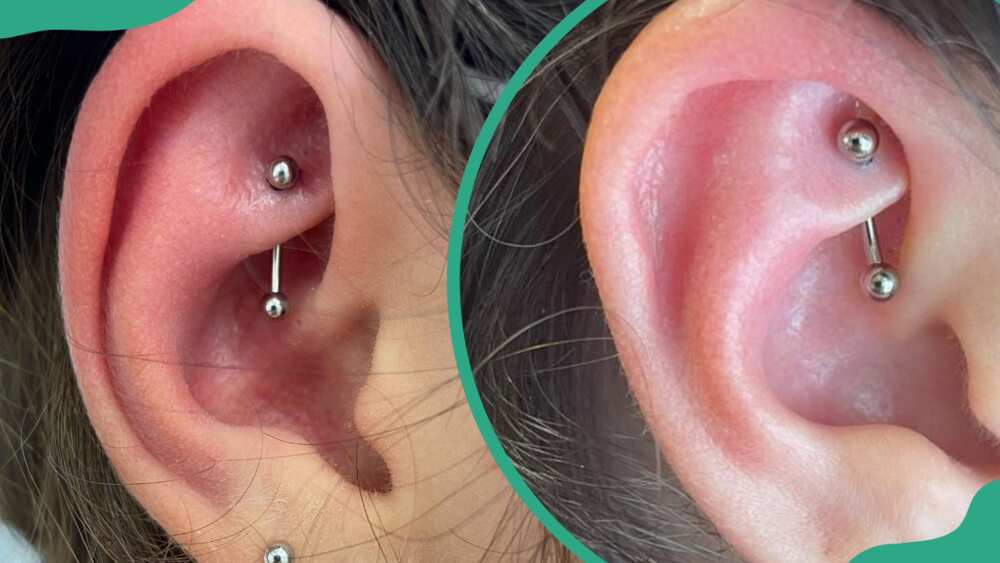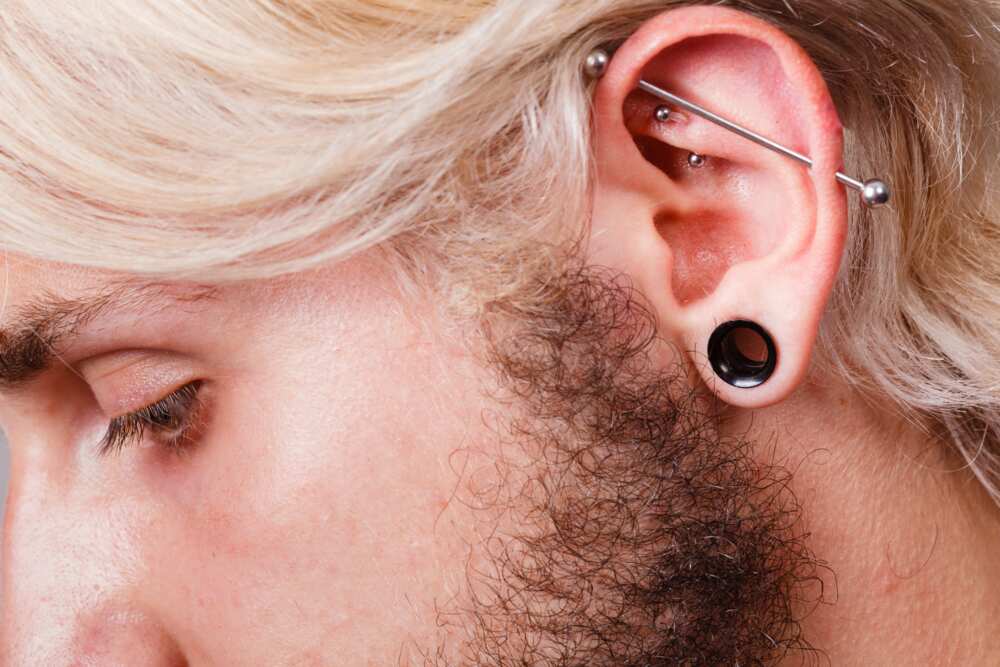Today, body piercings are more popular than ever, with people of all ages and backgrounds getting pierced for various reasons. Rook piercings have gained significant popularity in recent years, becoming a sought-after choice for individuals seeking unique and stylish ear piercings. This post has all you need to know about rook piercings, including the rook piercing's pain level, healing time and meaning.
 Rook piercings are one of the more unusual inner-ear piercings delicately placed within the inner ear. Photo: @specbodyart, @notjustapiercer on Instagram (modified by author)
Rook piercings are one of the more unusual inner-ear piercings delicately placed within the inner ear. Photo: @specbodyart, @notjustapiercer on Instagram (modified by author)Source: UGC
TABLE OF CONTENTS
Rook piercings are captivating forms of body art that allow individuals to express their style and individuality. They are one of the more unusual inner-ear piercings delicately placed within the inner ear. If you like inner ear piercings but want something unusual, the rook piercing may be for you.
What is rook piercing?
A rook piercing is a type of ear piercing that is done in the cartilage fold located above the tragus and just below the outer ridge of the ear. It involves creating a small hole through the thick cartilage fold located between the inner and outer conch of the ear. It should not be mistaken for a daith piercing, which is located directly above the ear canal on the minor ridge.
This piercing is named after its location in the ridge of cartilage known as the rook. If you are looking for an edgy new piercing, the rook is one spot you may want to check out. But before attempting it, there are a few things you should know about rook piercings, such as the possibility of a lengthy and painful recovery.
Rook piercing pain
 A rook piercing is more painful than some other types of ear piercing. Photo: @thebellybarcanterbury, Piercings by Molly on Facebook (modified by author)
A rook piercing is more painful than some other types of ear piercing. Photo: @thebellybarcanterbury, Piercings by Molly on Facebook (modified by author)Source: UGC
Is a rook piercing painful? A rook piercing is more painful than some other types of ear piercing. The cartilage in your ear is thicker than the soft tissue in your earlobe, making it much harder to pierce. The rook is a cartilage fold, so piercing it can be difficult.
Rook piercing healing time
How long does a rook piercing take to heal? If there are no complications, a rook piercing typically takes 3 to 10 months to heal. You should avoid activities that irritate the ear and delay healing during this time.
How are rook piercings done?
The following highlights the general steps of a rook piercing procedure:
- Before the procedure begins, the piercer explains the process and potential risks.
- The piercer will usually clean the area around your ear with an antiseptic solution to minimize the risk of infection.
- With a sterile surgical marker, your piercer will mark the precise location on your ear where the rook piercing will be placed.
- The piercer will take a hollow needle, insert it through the mark on your rook, and out the other side, creating a hole for the piercing.
- After the piercing is made, your piercer will insert the piece of jewellery, usually a curved barbell or captive bead ring.
Aftercare for rook piercing
Cartilage piercing aftercare is essential for optimum healing and the quickest recovery time. There are some things you need to take care of after rook piercing. Some of the aftercare instructions include:
- Clean the new piercing gently with a sterile solution twice a day. Moisture increases the risk of infection.
- Ensure to dry the ear afterward with a hair dryer with cool settings.
- Wash your hands thoroughly before touching or washing your piercing.
- Be extra careful while removing clothes and styling hair to avoid snagging the rook earrings.
- Sleep on the opposite side of the piercing for extra care.
- Avoid swimming in pools, lakes, or public hot tubs for at least 2–3 weeks after getting the piercing.
- You do not have to rotate your piercing during cleaning or at any other time.
- Do not remove your jewellery until the site is completely healed. It can close up in minutes.
- Only dry your ear with clean paper towels. Don’t use clothes that could have bacteria on them.
- Rotate the piercing only when the area is wet.
- Avoid cleaning your piercing with hydrogen peroxide or alcohol. Both slow the healing process by killing new, healthy cells.
- Avoid using any ointment on the piercing since it can interfere with healing.
Potential risks and complications
 Generally, the rook piercing presents the same complications and risks as other cartilage piercings in the ear. Photo: Anetlanda
Generally, the rook piercing presents the same complications and risks as other cartilage piercings in the ear. Photo: AnetlandaSource: Getty Images
The rook piercing presents the same complications and risks as other cartilage piercings in the ear. While rook piercings are generally safe, it is important to be aware of potential risks and complications. These can include:
- Infection: Improper aftercare and sterilization measures can lead to the risk of bacterial or fungal infection. Some signs of infection may include redness, pus, and severe pain.
- Migration and rejection: The body may reject the piercing, causing it to migrate or push it out. This occurs as the skin's natural response to keeping foreign objects out or due to improper placement.
- Allergic reactions: If your body doesn't react well to the jewellery material, you might experience an allergic reaction. Poor-quality jewellery can also cause an allergic reaction.
- Discharge: During the healing stage, you may experience a minor skin infection that leads to a slightly creamy or yellow discharge.
- Risk of keloid formation: Some individuals may be prone to developing keloids or hypertrophic, which causes excessive raised scar tissue around the piercing area.
- Irritation bumps: Small, raised bumps near the rook piercing may be noticed during the initial healing process, indicating infection.
What type of jewellery can you use for a rook piercing?
Once you have decided to get a rook piercing, the next step is to choose the perfect jewellery to adorn it. The right jewellery can enhance the beauty of your piercing and showcase your personal style. Here are some popular options to consider:
- Curved barbell
- Circular barbell
- Captive bead ring (CBR)
- Hoops
- Stud
What jewellery material is used for rook piercing?
Rook piercings are vulnerable to infections while they are still new. It is important to use high-quality, hypoallergenic materials to minimise the risk of irritation or infection. The most commonly recommended materials are:
- Titanium
- Gold
- Niobium
What are the benefits of a rook piercing?
A rook piercing offers both aesthetic appeal and potential health benefits. Here are some benefits:
- Its versatility allows for numerous jewellery options.
- It may help relieve stress and anxiety.
- Offers a distinctive and stylish look due to its less common placement.
- Offers experience in cartilage healing for those interested in body modifications.
- Less likely to interfere with daily activities compared to facial piercings.
Rook piercing vs daith
These piercings are more tucked away in the ear. Their placement is the main difference between them, with the rook nestled in the upper cartilage and the daith in the middle cartilage. Additionally, rook piercings are usually more painful and take longer to heal.
Do rook piercings heal easily?
Rook piercings can take time to heal, typically around 6 months to 1 year. The healing process varies from person to person.
What does the rook piercing represent?
A rook piercing can represent several things, often varying based on personal interpretation and cultural context, including understated elegance, strength, individuality, fashion statement, rebellion and creativity.
When can I change my rook piercing?
You can begin changing out your rook piercing jewellery once it heals, usually between 6 and 12 months.
Rook piercing has gained mainstream popularity in recent years. It is a captivating form of body art that allows individuals to express their style and individuality. By understanding the procedure, aftercare, benefits, and potential risks, you can make informed decisions and ensure a successful rook piercing experience.
Legit.ng recently published an article about septum piercing. Piercings offer a fun and reversible option to change your appearance and self-expression. Unlike the steel hoops of the past, contemporary septum piercings are simple, subtle, and favoured by celebrities like Zendaya and Florence Pugh.
Septum piercings, which go through the cartilage between your nostrils, have increasingly become mainstream. They were once only associated with punks and cartoon bulls but have become popular partly because celebrities sport them. However, before going out of your way to get this stylish nose accent, here are expert insights into what to expect.
Source: Legit.ng
















 English (US) ·
English (US) ·